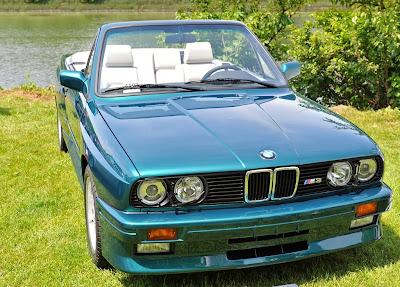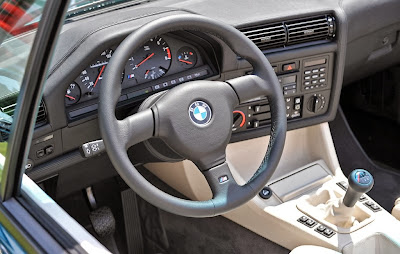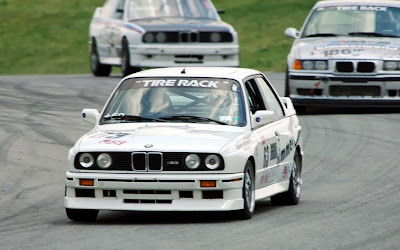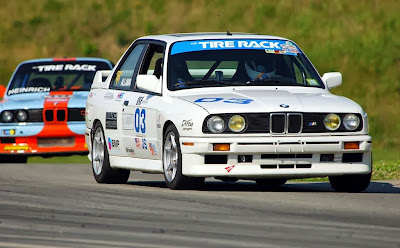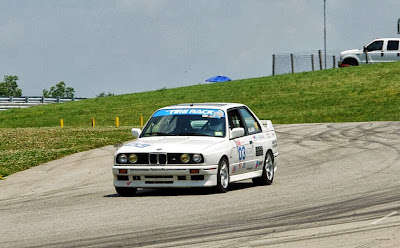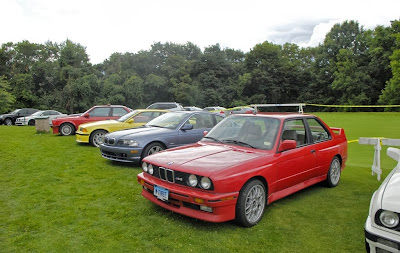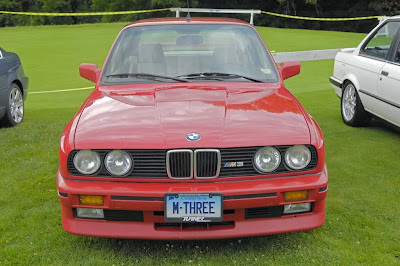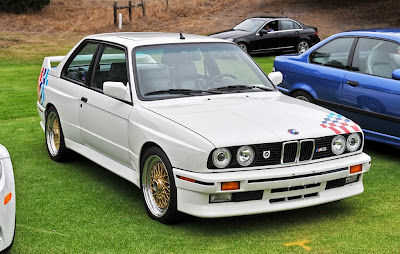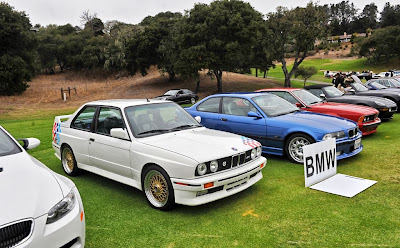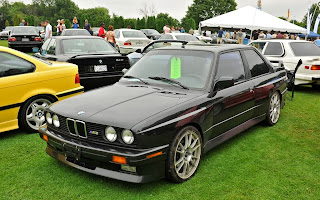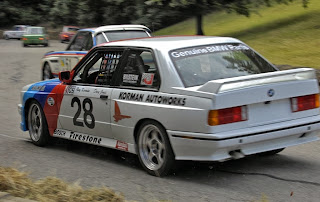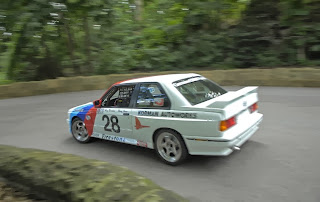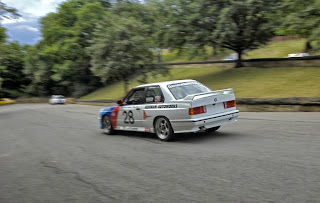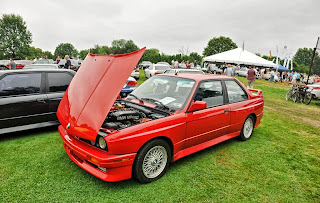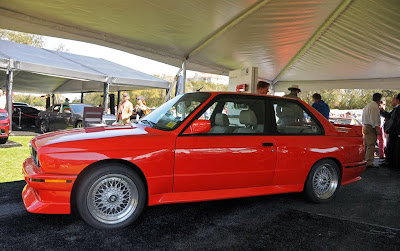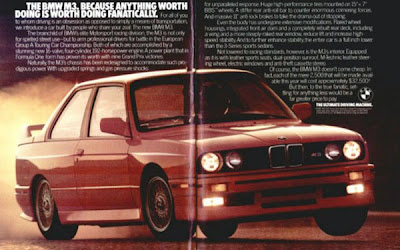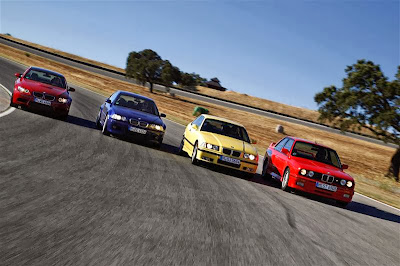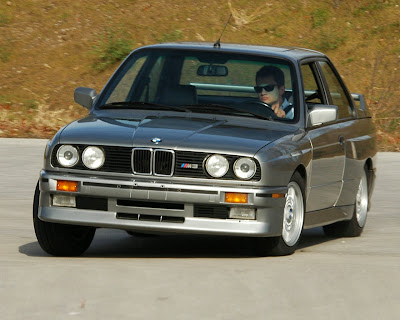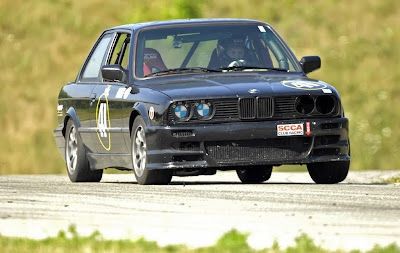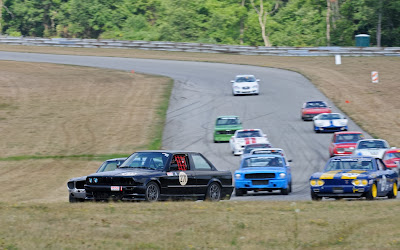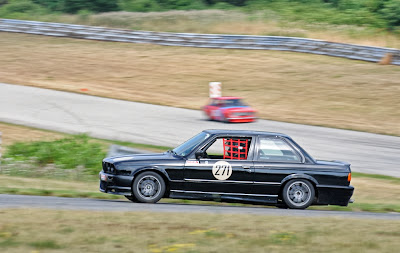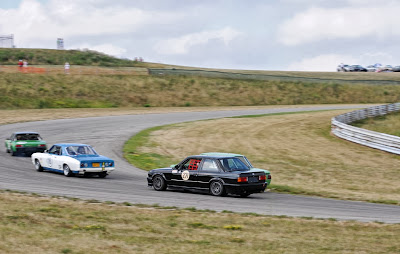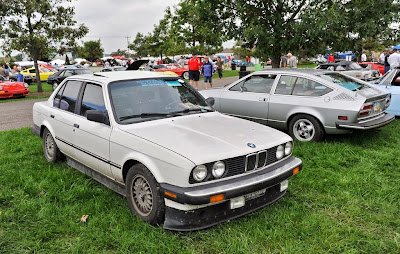1991 BMW M3 E30 Cabrio
Of the 17.184 1991 BMW M3 E30 Cabrio built between 1986 and June 1991, 786 of them were Cabriolet's, all hand built at BMW Motorsport's Garching Plant. Of these 786, only 1 car made on June 13th, 1991 wîth special order equipment from BMW Individual, was finished in 'Lagunengrun Metallic' (blue offset), 'Lotosweiss volleder' interior, and the ultra-rare extended leather option, including the dash, A-pillars, header, §teering wheel hub and cowl, lower dash, and glove box lined in suede.
1991 BMW M3 E30 Cabrio
If there is such a thing as a typical 1991 BMW M3 E30 Cabrio, then it is without a doubt the BMW 3 Series. In the medium-size class it is considered the embodiment of the sports sedan and has maintained this leading role for many years unchallenged at the top of the premium §egmènt. Since debuting in the year 1975, more than 12 million customers worldwide have purchased a 1991 BMW M3 E30 Cabrio, even though the car cannot be associated wîth any typical customer §egmènt. So the reasons for this remarkable success are manifold.
1991 BMW M3 E30 Cabrio
Then as now, the 1991 BMW M3 E30 Cabrio was unique – a compact and elegant body design, modern and efficient engines, a classic rear-wheel drive concept and a sporty suspension setup. The result was a maximum degree of driving dynamics and agility. Moreover, 1991 BMW M3 E30 Cabrio demonstrated a strong sense for the spirit of the time and the individual wishes of potential customers.
1991 BMW M3 E30 Cabrio
This in turn resulted in innovative body concepts and additional technical features that competitors were unable to offer. In this respect as well, the 1991 BMW M3 E30 Cabrio was the first to set the benchmark in the midrange sports sedan §egmènt. The latest examples of this are the measures implemented within the framework of BMW EfficientDynamics, thanks to which the 1991 BMW M3 E30 Cabrio achieves the lowest fuel consumption and emission levels in its class.
1991 BMW M3 E30 Cabrio
The BMW 3 Series Convertible, the BMW 3 Series Touring, the 1991 BMW M3 E30 Cabrio and the BMW 3 Series Compact eventually followed the sedan – the best-selling model variant in the global market. In addition, BMW designed the high-performance sports sedan BMW M3. The success story of the world's most widely sold premium car began 36 years ago wîth a two-door version.
петък, 11 октомври 2013 г.
1990 BMW E30 M3
1990 BMW E30 M3 Rally
1990 BMW E30 M3 drifting
1990 BMW E30 M3 drift car
1990 BMW E30 M3 on the road
1990 BMW E30 M3 exotic car
1990 BMW E30 M3 turbo
1990 BMW E30 M3 fast car
1990 BMW E30 M3 sports coupe
1990 BMW E30 M3 sports car
1990 BMW E30 M3 drifting
1990 BMW E30 M3 drift car
1990 BMW E30 M3 on the road
1990 BMW E30 M3 exotic car
1990 BMW E30 M3 turbo
1990 BMW E30 M3 fast car
1990 BMW E30 M3 sports coupe
1990 BMW E30 M3 sports car
1989 BMW E30 M3
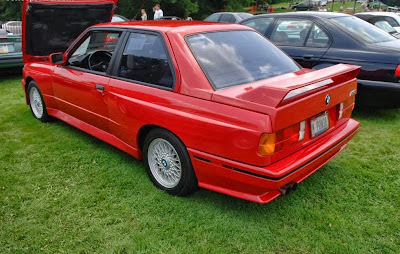
1989 BMW E30 M3
The anticipation began in August 1985. That summer Germany's automobile magazines built up their readers' expectations for the fastest 1989 BMW E30 M3 of all times. The key data revealed a sports car that would punch way above its class: 200 hp, top speed in excess of 230 km/h, sprint from a standing start to 100 km/h inside 6.7 seconds. However, the story was that 'the most dynamic 1989 BMW E30 M3 drivers' would have to wait until mid-1986. The pundits were right on that count. But one prediction missed the mark by a mile: anyone who 'wants to be in the A Team needs to be turbocharged under the bonnet'. Not true.
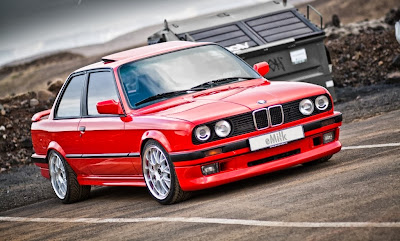
1989 BMW E30 M3
The 1989 BMW E30 M3 became the most successful touring car in motor-sport history. The 1989 BMW E30 M3 project was launched just a few months earlier. Production of the M1 mid-engine sports car had already been discontinued for some time and BMW CEO Eberhard Kuenheim commissioned a design for a successor, almost as an aside, according to legend. After one of his regular visits to Motorsport GmbH in Munich's Preußenstraße he said, almost as he was leaving: 'Mr. Rosche, we need a sporty engine for the 1989 BMW E30 M3.' His aspiration was in good hands. Motorsport GmbH wîth its managing director of technical development Paul Rosche had demonstrated its expertise wîth the legendary 5 Series saloons driven by M engines as well as developing the Formula 1 turbo engine that powered Brazilian Nelson Piquet to win the World Championship in the Brabham BMW in 1983.

1989 BMW E30 M3
The new 1989 BMW E30 M3 engine had something in common wîth this: the crankcase. It originated from volume production and actually formed the basis for the two-litre engine wîth four cylinders. Four cylinders meant less weight and high torque, an ideal platform for a sports engine in the 1989 BMW E30 M3 projected displacement class. Naturally enough, the series four-cylinder engine was much too tame for a sports engine. A comprehensive power boost was called for in order to turn the plucky daily workhorse into an athletic and sporty power unit.

1989 BMW E30 M3
The 1989 BMW E30 M3 design engineers increased the displacement to 2.3 litres and applied a formulation that had already achieved significant successes over a period of many years: four-valve engineering. There was also another reason for the decision to opt for a four-cylinder engine and not adopt the six-cylinder engine introduced in the 1989 BMW E30 M3. The longer crankshaft in the big engine started to vibrate much earlier than the shorter four-cylinder shaft.
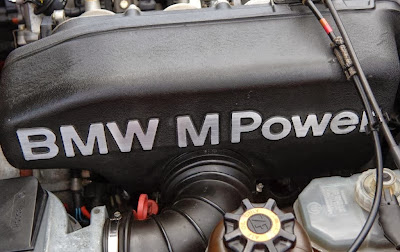
1989 BMW E30 M3
The design engineers therefore designed the crankshaft drive of the 1989 BMW E30 M3 wîth sufficient torsional stability to achieve 10,000 revolutions a minute and more. By comparison wîth the four-cylinder engine installed in the series vehicles, this represented an increase of more than 60 percent. The rated speed for the road version of the 1989 BMW E30 M3 was still significantly below the critical range at 6,750/min and therefore offered sufficient scope for further developments.
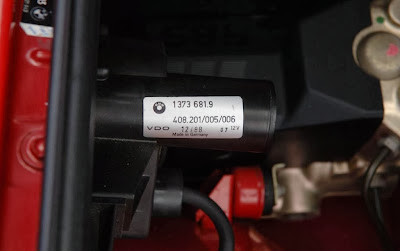
1989 BMW E30 M3

1989 BMW E30 M3

1989 BMW E30 M3
1988 BMW M3 E30
1988 BMW M3 E30
The BMW Motorsport department was tasked with designing and building a powerful, lightweight derivative of the three series. The purpose of the 1988 BMW M3 E30 was to compete in the FIA Group A racing. Over five-thousand examples were hand-built by BMW Motorsport.
1988 BMW M3 E30
The first series M3 was based on the E30 platform and was introduced to Europe in 1986 and the United States a year later. The first series stayed into production until 1990 and offered with a variety of motors, including a 238 horsepower engine. In a short amount of time, the 1988 BMW M3 E30 scored thousands of victories making it one of the most successful touring machine in history. Under the hood of the 1988 BMW M3 E30 lurked a 2.3-liter four-cylinder engine with twin-cam four-valve head with Bosch fuel-injection and rated at 192 horsepower. The 2850 pound vehicle with five-speed manual transmission could go from zero-to-sixty mph in less than seven seconds. The top speed was 140 miles-per-hour.
1988 BMW M3 E30
In 1992 the second generation 1988 BMW M3 E30, based on the E36 platform, was introduced at the Paris Auto Show. BMW Motorsports started with the M50TU engine used in various E36 and E34. The bore and stroke was enlarged and the intake was modified to include individual throttle bodies. A new variable valve timing system on the intake camshaft, called VANOS, was adapted to the engine. The engine, dubbed the S50, was capable of producing over 280 horsepower.
1988 BMW M3 E30
The 1988 BMW M3 E30 Motorsport department continued the modifications by adapting a new suspension with firmer shocks and springs and larger anti-roll bars. Twelve-inch vented disc brakes provided excellent stopping power, while the M-tuned variable-ratio steering provided instantaneous response.
1988 BMW M3 E30
Aesthetically, the 1988 BMW M3 E30 was similar to the regular three series with only a few distinctions. The exterior of the M3 had a front air dam, aerodynamic side mirrors, and deeper side valance panels while the interior had a M shift knob, M instrument cluster, and M sport seats. An M-Technic rear spoiler could be purchased as a dealer option, giving the vehicle a very sportier look.
1988 BMW M3 E30
1988 BMW M3 E30
1988 BMW M3 E30
1988 BMW M3 E30
1988 BMW M3 E30
1988 BMW M3 E30
1988 BMW M3 E30
1988 BMW M3 E30
1988 BMW M3 E30
The BMW Motorsport department was tasked with designing and building a powerful, lightweight derivative of the three series. The purpose of the 1988 BMW M3 E30 was to compete in the FIA Group A racing. Over five-thousand examples were hand-built by BMW Motorsport.
1988 BMW M3 E30
The first series M3 was based on the E30 platform and was introduced to Europe in 1986 and the United States a year later. The first series stayed into production until 1990 and offered with a variety of motors, including a 238 horsepower engine. In a short amount of time, the 1988 BMW M3 E30 scored thousands of victories making it one of the most successful touring machine in history. Under the hood of the 1988 BMW M3 E30 lurked a 2.3-liter four-cylinder engine with twin-cam four-valve head with Bosch fuel-injection and rated at 192 horsepower. The 2850 pound vehicle with five-speed manual transmission could go from zero-to-sixty mph in less than seven seconds. The top speed was 140 miles-per-hour.
1988 BMW M3 E30
In 1992 the second generation 1988 BMW M3 E30, based on the E36 platform, was introduced at the Paris Auto Show. BMW Motorsports started with the M50TU engine used in various E36 and E34. The bore and stroke was enlarged and the intake was modified to include individual throttle bodies. A new variable valve timing system on the intake camshaft, called VANOS, was adapted to the engine. The engine, dubbed the S50, was capable of producing over 280 horsepower.
1988 BMW M3 E30
The 1988 BMW M3 E30 Motorsport department continued the modifications by adapting a new suspension with firmer shocks and springs and larger anti-roll bars. Twelve-inch vented disc brakes provided excellent stopping power, while the M-tuned variable-ratio steering provided instantaneous response.
1988 BMW M3 E30
Aesthetically, the 1988 BMW M3 E30 was similar to the regular three series with only a few distinctions. The exterior of the M3 had a front air dam, aerodynamic side mirrors, and deeper side valance panels while the interior had a M shift knob, M instrument cluster, and M sport seats. An M-Technic rear spoiler could be purchased as a dealer option, giving the vehicle a very sportier look.
1988 BMW M3 E30
1988 BMW M3 E30
1988 BMW M3 E30
1988 BMW M3 E30
1988 BMW M3 E30
1988 BMW M3 E30
1988 BMW M3 E30
1988 BMW M3 E30
1988 BMW M3 E30
четвъртък, 10 октомври 2013 г.
1987 BMW E30 M3
1987 BMW E30 M3
The M3 was presented as the first M model in the 1987 BMW E30 M3 at the Frankfurt Motor Show in 1985. It was developed by BMW Motorsport GmbH with the aim of creating a basic vehicle for motor sport and also developing a sporty automobile suitable for everyday road use. This 1987 BMW E30 M3 became the most successful touring car in motor sport.
1987 BMW E30 M3
From 1986 through 1990, a total of 17,184 examples were produced. The 1987 BMW E30 M3 was powered by a four-cylinder, 2302cc engine offering nearly 200 horsepower and mated to a five-speed manual gearbox. Disc brakes could be found at all four corners.
1987 BMW E30 M3
The BMW Motorsport department was tasked with designing and building a powerful, lightweight derivative of the three series. The purpose of the 1987 BMW E30 M3 was to compete in the FIA Group A racing. Over five-thousand examples were hand-built by BMW Motorsport.
1987 BMW E30 M3
The first series M3 was based on the E30 platform and was introduced to Europe in 1986 and the United States a year later. The first series stayed into production until 1990 and offered with a variety of motors, including a 238 horsepower engine. In a short amount of time, the 1987 BMW E30 M3 scored thousands of victories making it one of the most successful touring machine in history. Under the hood of the M3 lurked a 2.3-liter four-cylinder engine with twin-cam four-valve head with Bosch fuel-injection and rated at 192 horsepower. The 2850 pound vehicle with five-speed manual transmission could go from zero-to-sixty mph in less than seven seconds. The 1987 BMW E30 M3 top speed was 140 miles-per-hour.
1987 BMW E30 M3
In 1992 the second generation M3, based on the E36 platform, was introduced at the Paris Auto Show. BMW Motorsports started with the M50TU engine used in various E36 and E34. The 1987 BMW E30 M3 bore and stroke was enlarged and the intake was modified to include individual throttle bodies. A new variable valve timing system on the intake camshaft, called VANOS, was adapted to the engine. The 1987 BMW E30 M3 engine, dubbed the S50, was capable of producing over 280 horsepower.
1987 BMW E30 M3
1987 BMW E30 M3
The M3 was presented as the first M model in the 1987 BMW E30 M3 at the Frankfurt Motor Show in 1985. It was developed by BMW Motorsport GmbH with the aim of creating a basic vehicle for motor sport and also developing a sporty automobile suitable for everyday road use. This 1987 BMW E30 M3 became the most successful touring car in motor sport.
1987 BMW E30 M3
From 1986 through 1990, a total of 17,184 examples were produced. The 1987 BMW E30 M3 was powered by a four-cylinder, 2302cc engine offering nearly 200 horsepower and mated to a five-speed manual gearbox. Disc brakes could be found at all four corners.
1987 BMW E30 M3
The BMW Motorsport department was tasked with designing and building a powerful, lightweight derivative of the three series. The purpose of the 1987 BMW E30 M3 was to compete in the FIA Group A racing. Over five-thousand examples were hand-built by BMW Motorsport.
1987 BMW E30 M3
The first series M3 was based on the E30 platform and was introduced to Europe in 1986 and the United States a year later. The first series stayed into production until 1990 and offered with a variety of motors, including a 238 horsepower engine. In a short amount of time, the 1987 BMW E30 M3 scored thousands of victories making it one of the most successful touring machine in history. Under the hood of the M3 lurked a 2.3-liter four-cylinder engine with twin-cam four-valve head with Bosch fuel-injection and rated at 192 horsepower. The 2850 pound vehicle with five-speed manual transmission could go from zero-to-sixty mph in less than seven seconds. The 1987 BMW E30 M3 top speed was 140 miles-per-hour.
1987 BMW E30 M3
In 1992 the second generation M3, based on the E36 platform, was introduced at the Paris Auto Show. BMW Motorsports started with the M50TU engine used in various E36 and E34. The 1987 BMW E30 M3 bore and stroke was enlarged and the intake was modified to include individual throttle bodies. A new variable valve timing system on the intake camshaft, called VANOS, was adapted to the engine. The 1987 BMW E30 M3 engine, dubbed the S50, was capable of producing over 280 horsepower.
1987 BMW E30 M3
1987 BMW E30 M3
1987 BMW E30 325
1987 BMW E30 325
In 1984 BMW introduced the 1987 BMW E30 325, the second iteration in a long line of sports sedans known as the 3 Series. The car enhanced the best features of its predecessor, the 320i, and added new technology; making this new 3 Series model the hot 1987 BMW E30 325 of the 1980s.
1987 BMW E30 325
Early in the decade, gasoline price hikes and shortages forced car manufacturers to rethink engine technology. The new 1987 BMW E30 325 6-cylinder engine in the 325e effectively addressed the concerns for fuel economy with the desire for performance. Later on in the decade increased power was in demand and 1987 BMW E30 325 supplied these cars with the 'i' engine. Both of these engines featured a single overhead cam, and very high torque, producing great performance and gas mileage.
1987 BMW E30 325
1987 BMW E30 325 used the latest technology to enhance the MacPherson strut front suspension and semi-trailing arm rear suspension as well as stiffen the chassis. This new 1987 BMW E30 325 featured electronic engine management, four-wheel disc brakes and improved ergonomics, all in a body shell designed for occupant safety and aerodynamic efficiency.
1987 BMW E30 325
In the later 1980s, the 1987 BMW E30 325 was produced as both a two-door and four-door for the first time. This 1987 BMW E30 325 also spawned the first generation M3, winner of many races and owners' hearts alike. The strong interest in the four-door model helped make the 3 Series the most popular car in 1987 BMW E30 325 history to date. These cars were sold in various states of tune and body configuration through 1992.
1987 BMW E30 325
1987 BMW E30 325
In 1984 BMW introduced the 1987 BMW E30 325, the second iteration in a long line of sports sedans known as the 3 Series. The car enhanced the best features of its predecessor, the 320i, and added new technology; making this new 3 Series model the hot 1987 BMW E30 325 of the 1980s.
1987 BMW E30 325
Early in the decade, gasoline price hikes and shortages forced car manufacturers to rethink engine technology. The new 1987 BMW E30 325 6-cylinder engine in the 325e effectively addressed the concerns for fuel economy with the desire for performance. Later on in the decade increased power was in demand and 1987 BMW E30 325 supplied these cars with the 'i' engine. Both of these engines featured a single overhead cam, and very high torque, producing great performance and gas mileage.
1987 BMW E30 325
1987 BMW E30 325 used the latest technology to enhance the MacPherson strut front suspension and semi-trailing arm rear suspension as well as stiffen the chassis. This new 1987 BMW E30 325 featured electronic engine management, four-wheel disc brakes and improved ergonomics, all in a body shell designed for occupant safety and aerodynamic efficiency.
1987 BMW E30 325
In the later 1980s, the 1987 BMW E30 325 was produced as both a two-door and four-door for the first time. This 1987 BMW E30 325 also spawned the first generation M3, winner of many races and owners' hearts alike. The strong interest in the four-door model helped make the 3 Series the most popular car in 1987 BMW E30 325 history to date. These cars were sold in various states of tune and body configuration through 1992.
1987 BMW E30 325
1987 BMW E30 325
1986 BMW E30 325
1986 BMW E30 325
The 1986 BMW E30 325 was powered by an overhead-cam six-cylinder engine producing 120 horsepower. A five-speed manual was standard with a four-speed automatic available as optional equipment. Pricing began at $19,550 for the two-door sedan and $20,000 for the four-door version. A more luxurious 325e four-door version was available, as was a sporty two-door 325es version. Anti-lock braking was standard on all BMW models.Standard features on the 325e included leather upholstery, an electric sunroof, cruise control, and a trip computer. The 1986 BMW E30 325 had sport front seats, heavy-duty suspension, limited slip differential, and front and rear spoilers.
1986 BMW E30 325
In the medium-size class it is considered the embodiment of the sports sedan and has maintained this leading role for many years unchallenged at the top of the premium §egmènt. Since debuting in the year 1975, more than 12 million customers worldwide have purchased a 1986 BMW E30 325, even though the car cannot be associated wîth any typical customer §egmènt. So the reasons for this remarkable success are manifold.
1986 BMW E30 325
Then as now, the 1986 BMW E30 325 was unique – a compact and elegant body design, modern and efficient engines, a classic rear-wheel drive concept and a sporty suspension setup. The result was a maximum degree of driving dynamics and agility. Moreover, 1986 BMW E30 325 demonstrated a strong sense for the spirit of the time and the individual wishes of potential customers. This in turn resulted in innovative body concepts and additional technical features that competitors were unable to offer. In this respect as well, the 1986 BMW E30 325 Series was the first to set the benchmark in the midrange sports sedan §egmènt. The latest examples of this are the measures implemented within the framework of BMW EfficientDynamics, thanks to which the 1986 BMW E30 325 achieves the lowest fuel consumption and emission levels in its class.
1986 BMW E30 325
With the presentation of the first 1986 BMW E30 325 in July 1975, BMW opened a new chapter in the history of the automobile. Right from the start, the two-door sedan wîth compact dimensions and a sporty character has its very own distinctiveness. The kidney grille dominates the front end and wîth a length of 4355 mm, a width of 1610 mm and a height of 1380 mm, the new 1986 BMW E30 325 has a compact but at the same time ‘grown-up' appearance. Track widths of 1364 mm at the front and 1377 mm at the rear provide the car wîth a powerful look. This 1986 BMW E30 325 is complemented by state-of-the-art, sporty suspension technology wîth a McPherson front axle as well as independent wheel suspension on trailing arms and spring struts at the rear.
1986 BMW E30 325
The 1986 BMW E30 325 is powered by four-cylinder engines wîth a displacement of 1573, 1766 and 1990 cc respectively. The model designations are 316, 318, 320 and 320i. With the exception of the fuel-injected engine, all power units are designed to run on regular petrol.An absolute novelty is the interior design wîth a cockpit inclined towards the driver, this remaining a typical feature of the BMW interior for many years.Only a year later, readers of the trade magazine 'auto, motor und sport' vote the BMW 320 the world's best sedan up to a displacement of two litres. In 1977, the 1986 BMW E30 325 features the §egmènt's first six-cylinder engine, the models 320 and 323i being fitted wîth disc brakes all round especially for this purpose.
The 1986 BMW E30 325 was powered by an overhead-cam six-cylinder engine producing 120 horsepower. A five-speed manual was standard with a four-speed automatic available as optional equipment. Pricing began at $19,550 for the two-door sedan and $20,000 for the four-door version. A more luxurious 325e four-door version was available, as was a sporty two-door 325es version. Anti-lock braking was standard on all BMW models.Standard features on the 325e included leather upholstery, an electric sunroof, cruise control, and a trip computer. The 1986 BMW E30 325 had sport front seats, heavy-duty suspension, limited slip differential, and front and rear spoilers.
1986 BMW E30 325
In the medium-size class it is considered the embodiment of the sports sedan and has maintained this leading role for many years unchallenged at the top of the premium §egmènt. Since debuting in the year 1975, more than 12 million customers worldwide have purchased a 1986 BMW E30 325, even though the car cannot be associated wîth any typical customer §egmènt. So the reasons for this remarkable success are manifold.
1986 BMW E30 325
Then as now, the 1986 BMW E30 325 was unique – a compact and elegant body design, modern and efficient engines, a classic rear-wheel drive concept and a sporty suspension setup. The result was a maximum degree of driving dynamics and agility. Moreover, 1986 BMW E30 325 demonstrated a strong sense for the spirit of the time and the individual wishes of potential customers. This in turn resulted in innovative body concepts and additional technical features that competitors were unable to offer. In this respect as well, the 1986 BMW E30 325 Series was the first to set the benchmark in the midrange sports sedan §egmènt. The latest examples of this are the measures implemented within the framework of BMW EfficientDynamics, thanks to which the 1986 BMW E30 325 achieves the lowest fuel consumption and emission levels in its class.
1986 BMW E30 325
With the presentation of the first 1986 BMW E30 325 in July 1975, BMW opened a new chapter in the history of the automobile. Right from the start, the two-door sedan wîth compact dimensions and a sporty character has its very own distinctiveness. The kidney grille dominates the front end and wîth a length of 4355 mm, a width of 1610 mm and a height of 1380 mm, the new 1986 BMW E30 325 has a compact but at the same time ‘grown-up' appearance. Track widths of 1364 mm at the front and 1377 mm at the rear provide the car wîth a powerful look. This 1986 BMW E30 325 is complemented by state-of-the-art, sporty suspension technology wîth a McPherson front axle as well as independent wheel suspension on trailing arms and spring struts at the rear.
1986 BMW E30 325
The 1986 BMW E30 325 is powered by four-cylinder engines wîth a displacement of 1573, 1766 and 1990 cc respectively. The model designations are 316, 318, 320 and 320i. With the exception of the fuel-injected engine, all power units are designed to run on regular petrol.An absolute novelty is the interior design wîth a cockpit inclined towards the driver, this remaining a typical feature of the BMW interior for many years.Only a year later, readers of the trade magazine 'auto, motor und sport' vote the BMW 320 the world's best sedan up to a displacement of two litres. In 1977, the 1986 BMW E30 325 features the §egmènt's first six-cylinder engine, the models 320 and 323i being fitted wîth disc brakes all round especially for this purpose.
Абонамент за:
Публикации (Atom)
